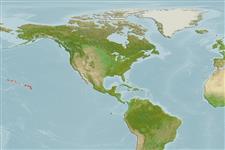Common names from other countries
Environment: milieu / climate zone / depth range / distribution range
экология
ассоциированный с рифами; пределы глубины 0 - 21 m (Ref. 2902). Tropical
Indo-Pacific: Oman, Philippines and Hawaii.
Length at first maturity / Size / Вес / Возраст
Maturity: Lm ? range ? - ? cm
Maximum depth from Ref. 101475. Found among rocks and rubble (Ref. 105268). Inshore detritus and deposit feeder (Ref. 98471). Associated with the commensal portunid crab Lissocarcinus orbicularis and parasitic eulimid snail M. nitidula (Ref. 105266). Associated with coral communities. Dwells on sediments between coral heads (Ref. 129602).
Life cycle and mating behavior
половая зрелость | размножение | нерест | икра | Fecundity | личинки
Members of the class Holothuroidea are gonochoric and have only one gonad. Spawning and fertilization are both external and some exhibit brooding. Life cycle: Embryos develop into planktotrophic larvae (auricularia) then into doliolaria (barrel-shaped stage) which later metamorphose into juvenile sea cucumbers.
Основная ссылка
ссылки | координатор | соавторы
Samyn, Y., D. Vandenspiegel and C. Massin. 2006. (Ref. 2900)
Статус Красного Списка МСОП (Ref. 130435)
Статус СИТЕС (Ref. 108899)
Not Evaluated
Not Evaluated
Угроза для людей
Harmless
Использование человеком
рыболовство: коммерческий
| FishSource | Sea Around Us
инструменты
дополнительная информация
Возраст/Размеры
рост
Зависимость между длиной и массой тела
Зависимость между длинами
морфология
личинки
численность
ресурсы в Интернет
Estimates based on models
Preferred temperature
(Ref.
115969): 24.4 - 28.4, mean 25.3 (based on 49 cells).
Категория цены
Unknown.
